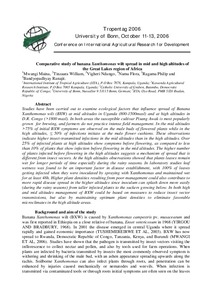| dc.contributor.author | Maina, M. |
| dc.contributor.author | William, T. |
| dc.contributor.author | Ndungo, V. |
| dc.contributor.author | Flora, N. |
| dc.contributor.author | Philip, R. |
| dc.contributor.author | Ranajit, B. |
| dc.date.accessioned | 2019-12-04T11:15:41Z |
| dc.date.available | 2019-12-04T11:15:41Z |
| dc.date.issued | 2006 |
| dc.identifier.citation | Maina, M., William, T., Ndungo, V., Flora, N., Philip, R. & Ranajit, B. (2006). Comparative study of banana Xanthomonas wilt spread in mid and high altitudes of the Great Lakes region of Africa. Conference on International Agricultural Research for Development (p. 5). Bonn: University of Bonn. |
| dc.identifier.uri | https://hdl.handle.net/20.500.12478/3011 |
| dc.description.abstract | Studies have been carried out to examine ecological factors that influence spread of Banana Xanthomonas wilt (BXW) at mid altitudes in Uganda (800-1500masl) and at high altitudes in D.R. Congo (>1800 masl). In both areas the susceptible cultivar Pisang Awak is most popularly grown for brewing, and farmers do not practice intense field management. In the mid altitudes >75% of initial BXW symptoms are observed on the male buds of flowered plants while in the high altitudes, ≤50% of infections initiate at the male flower cushions. These observations indicate higher insect-transmitted infections in the mid altitudes than in the high altitudes. Over 25% of infected plants at high altitudes show symptoms before flowering, as compared to less than 10% of plants that show infection before flowering in the mid altitudes. The higher number of plants infected before flowering in the high altitudes suggests a mechanism of spread that is different from insect vectors. At the high altitudes observations showed that plants leaves remain wet for longer periods of time especially during the rainy seasons. In laboratory studies leaf wetness was found to be an important factor in disease establishment, with 100% of leaves getting infected when they were inoculated by spraying with Xanthomonas and maintained wet for at least 48h. Higher plant densities resulting from poor management could also contribute to more rapid disease spread in the higher altitudes since inoculum can splash down more easily (during the rainy seasons) from taller infected plants to the suckers growing below. In both high and mid altitudes management of BXW could be based on measures to reduce insect vector transmissions, but also by maintaining optimum plant densities to eliminate favorable microclimates in the high altitude areas. |
| dc.language.iso | en |
| dc.subject | Banana Xanthomonas Wilt |
| dc.subject | Infections |
| dc.subject | Nematode |
| dc.subject | Symptoms |
| dc.subject | Pathogen |
| dc.subject | Disease Spread |
| dc.subject | Insect Vectors |
| dc.title | Comparative study of banana Xanthomonas wilt spread in mid and high altitudes of the Great Lakes region of Africa |
| dc.type | Conference Proceedings |
| dc.description.version | Peer Review |
| cg.contributor.affiliation | International Institute of Tropical Agriculture |
| cg.contributor.affiliation | Kawanda Agricultural Research Institute, Uganda |
| cg.contributor.affiliation | Catholic University of Graben |
| cg.contributor.affiliation | University of Bonn |
| cg.coverage.region | Africa |
| cg.coverage.region | Acp |
| cg.coverage.region | East Africa |
| cg.coverage.region | Central Africa |
| cg.coverage.region | Europe |
| cg.coverage.region | West Africa |
| cg.coverage.country | Uganda |
| cg.coverage.country | Congo, Dr |
| cg.coverage.country | Germany |
| cg.coverage.country | Nigeria |
| cg.authorship.types | CGIAR and developing country institute |
| cg.iitasubject | Disease Control |
| cg.iitasubject | Banana |
| cg.iitasubject | Smallholder Farmers |
| cg.iitasubject | Plant Production |
| cg.iitasubject | Livelihoods |
| cg.iitasubject | Food Security |
| cg.iitasubject | Agribusiness |
| cg.iitasubject | Handling, Transport, Storage And Protection Of Agricultural Products |
| cg.iitasubject | Post-Harvesting Technology |
| cg.iitasubject | Farm Management |
| cg.iitasubject | Pests Of Plants |
| cg.iitasubject | Plant Breeding |
| cg.iitasubject | Plant Genetic Resources |
| cg.iitasubject | Plant Diseases |
| cg.iitasubject | Markets |
| cg.iitasubject | Genetic Improvement |
| cg.accessibilitystatus | Limited Access |
| local.dspaceid | 94477 |

